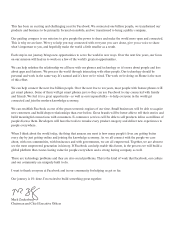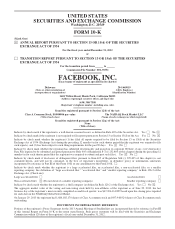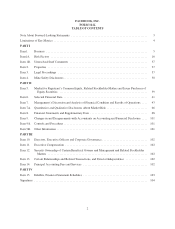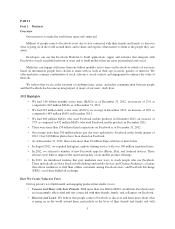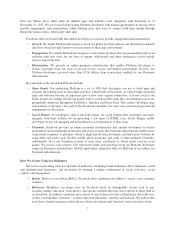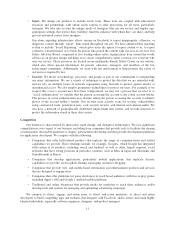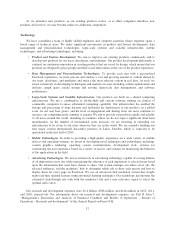Facebook 2012 Annual Report Download - page 8
Download and view the complete annual report
Please find page 8 of the 2012 Facebook annual report below. You can navigate through the pages in the report by either clicking on the pages listed below, or by using the keyword search tool below to find specific information within the annual report.LIMITATIONS OF KEY METRICS
The numbers of our monthly active users (MAUs), daily active users (DAUs), mobile MAUs, and average
revenue per user (ARPU) are calculated using internal company data based on the activity of user accounts.
While these numbers are based on what we believe to be reasonable estimates of our user base for the applicable
period of measurement, there are inherent challenges in measuring usage of our products across large online and
mobile populations around the world. For example, there may be individuals who maintain one or more
Facebook accounts in violation of our terms of service. We estimate, for example, that “duplicate” accounts (an
account that a user maintains in addition to his or her principal account) may have represented approximately
5.0% of our worldwide MAUs as of December 31, 2012. We also seek to identify “false” accounts, which we
divide into two categories: (1) user-misclassified accounts, where users have created personal profiles for a
business, organization, or non-human entity such as a pet (such entities are permitted on Facebook using a Page
rather than a personal profile under our terms of service); and (2) undesirable accounts, which represent user
profiles that we determine are intended to be used for purposes that violate our terms of service, such as
spamming. As of December 31, 2012, for example, we estimate user-misclassified accounts may have
represented approximately 1.3% of our worldwide MAUs and undesirable accounts may have represented
approximately 0.9% of our worldwide MAUs. We believe the percentage of accounts that are duplicate or false is
meaningfully lower in developed markets such as the United States or Australia and higher in developing
markets such as Indonesia and Turkey. However, these estimates are based on an internal review of a limited
sample of accounts and we apply significant judgment in making this determination, such as identifying names
that appear to be fake or other behavior that appears inauthentic to the reviewers. As such, our estimation of
duplicate or false accounts may not accurately represent the actual number of such accounts. We are continually
seeking to improve our ability to identify duplicate or false accounts and estimate the total number of such
accounts, and such estimates may change due to improvements or changes in our methodology.
Some of our historical metrics through the second quarter of 2012 have also been affected by applications
on certain mobile devices that automatically contact our servers for regular updates with no user action involved,
and this activity can cause our system to count the user associated with such a device as an active user on the day
such contact occurs. For example, we estimate that less than 5% of our estimated worldwide DAUs as of
December 31, 2011 and 2010 resulted from this type of automatic mobile activity, and that this type of activity
had a substantially smaller effect on our estimate of worldwide MAUs and mobile MAUs. The impact of this
automatic activity on our metrics varies by geography because mobile usage varies in different regions of the
world. In addition, our data regarding the geographic location of our users is estimated based on a number of
factors, such as the user’s IP address and self-disclosed location. These factors may not always accurately reflect
the user’s actual location. For example, a mobile-only user may appear to be accessing Facebook from the
location of the proxy server that the user connects to rather than from the user’s actual location. The
methodologies used to measure user metrics may also be susceptible to algorithm or other technical errors. For
example, in early June 2012, we discovered an error in the algorithm we used to estimate the geographic location
of our users that affected our attribution of certain user locations for the period ended March 31, 2012. While this
issue did not affect our overall worldwide MAU number, it did affect our attribution of users to different
geographic regions. We estimate that the number of MAUs as of March 31, 2012 for the United States & Canada
region was overstated as a result of the error by approximately 3% and these overstatements were offset by
understatements in other regions. Our estimates for revenue by user location and revenue by user device are also
affected by these factors. We regularly review and may adjust our processes for calculating these metrics to
improve their accuracy. In addition, our MAU and DAU estimates will differ from estimates published by third
parties due to differences in methodology. For example, some third parties are not able to accurately measure
mobile users or do not count mobile users for certain user groups or at all in their analyses.
The numbers of MAUs, DAUs, and mobile MAUs discussed in this Annual Report on Form 10-K, as well
as ARPU, do not include users of Instagram unless such users would otherwise qualify as MAUs, DAUs, and
mobile MAUs, respectively, based on activity that is shared back to Facebook. In addition, our other user
engagement metrics, such as friend connections, do not include Instagram unless otherwise specifically stated.
4



